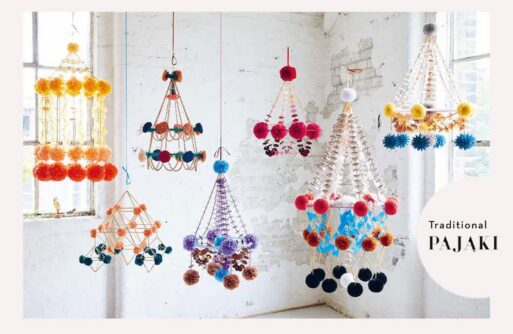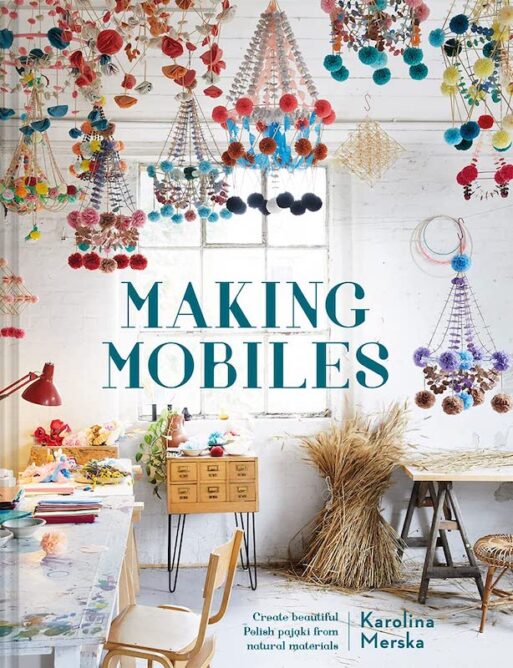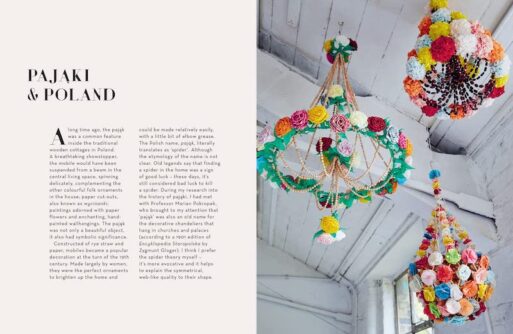Karolina Merska’s beautiful book, “Making Mobiles,” is a loving ode to an almost-forgotten art. In it, she details how to craft Polish folk art decorations called Pajaki. Although they were more traditionally made and hung for holidays like Christmas and Easter, Merska hopes that by adding some contemporary flair these pompom-laden chandeliers could adorn one’s home year-round. With their delicate, airy design, pajaki could also be a cheerful decoration to display at a celebration of life.
A Bit of Background
Pajaki (or pajak in the singular) are delicate, colorful mobiles traditionally crafted from rye straw, paper, wool, feathers, and dried peas. Variations of the craft can be found all over Eastern Europe, but the Polish pajaki are by far the most vibrant. Merska first stumbled upon pajaki hanging in one of the traditional houses at the Open Air Village Museum in Lublin, Poland, and has been on a quest to preserve the art ever since.

Many inspiring DIY mobiles perfect for a teen or a child’s celebration of life
Credit: Bolt Fabric Boutique
Karolina Merska studied History of Art at the Jagiellonian University in Kraków, and developed a keen interest in the ethnography and history of traditional Polish folk culture. According to her, Pajaki are “steeped in history and symbolism” – which we wish Merska had delved into further, but perhaps that would be a different kind of book.
Making pajaki is unfortunately a dying craft, practiced primarily by elderly women who were taught by their mothers and grandmothers. So, in “Making Mobiles,” Merska instead focuses on sharing the methods she’s learned for making pajaki from her own practice, as well as with the help of three Polish artisans: Helena, Zofia and Jósef. Merska’s dream is to revitalize the craft as a traditional art form, a meditative practice and a creative outlet for engaging with family members.
Pajaki as Symbolic Decór
Straw – a primary crop and the backbone of a traditional pajak – played a critical role in country life for Polish people hundreds of years ago. In many homes, it was used frequently in decorations as well as scattered throughout the house to ward off evil spirits.
“The belief was that a straw pajak hanging above the table was supposed to bring a good harvest, prosperity and happiness in the coming year. After Christmas, new pajaki were made for Easter celebrations. The Christmas pajak was burned as a symbol of a new chapter and to affirm the reawakening of nature.”
Knowing this, and that pajaki were also used to decorate for weddings, christenings and other celebrations, it follows that they could also be made to adorn memorial services or celebrations of life, although Merska doesn’t directly allude to this usage.
“Making Mobiles” In Memory of a Loved One
Although it might seem like a bit of a leap, Merska’s tutorials could be a helpful tool for someone who is grieving. The elaborate individual decorations that are painstakingly made out of paper and straw are just repetitive enough to assist in a meditative practice.
Alternatively, when everything else feels too hard to accomplish, making a craft like a pajaki could give someone a sense of accomplishment, or at least keep their hands busy as they process their grief. And then, at the end of the celebration of life or memorial service, the pajaki could be burnt symbolically as well, to represent releasing the pain and sadness and embarking upon the rest of life’s journey.

 “Making Mobiles” by Karolina Merska
“Making Mobiles” by Karolina Merska




 John Mulaney’s “Funeral Planning” on Netflix: No Real Plan
John Mulaney’s “Funeral Planning” on Netflix: No Real Plan

 Composting Bodies Is Now Legal in a Dozen States
Composting Bodies Is Now Legal in a Dozen States














